By Evan Yares, Senior Editor & Analyst, Software
SolidWorks 2013 may be one of the best releases ever.
SolidWorks Corporation was founded in 1993. The company’s initial plan was elegantly simple: build a CAD program that runs on Microsoft Windows, competes with Pro/Engineer, and sells for $4,000, through local resellers.
Today, almost 20 years later, there have been a few changes. SolidWorks Corporation is now part of Dassault Systèmes, and is called Dassault Systèmes SolidWorks Corp. In addition to selling SolidWorks (which has become the most popular mainstream MCAD program in the world), the company also sells product data management, simulation, and technical documentation software.
What hasn’t changed all that much is the essential character of the SolidWorks software. It still runs on Microsoft Windows, it still competes with Pro/E (as well as other CAD systems), it’s still priced at $4,000 (though most users opt for the more capable and expensive Premium or Professional versions), and it’s still sold through local resellers.
DS SolidWorks (the company) has delivered one or two new versions of SolidWorks software every year since 1995. This year, they are delivering SolidWorks 2013. It may be that this version is one of the company’s most important, ever.
A new version, an old architecture
SolidWorks has seen tremendous improvements in capability over the years. Large chunks of the program have been torn out, and rewritten. Major subsystems have been added. Yet, today’s SolidWorks, at its heart, is a mature program. It is built on a nearly 20 year-old software architecture.
Several years ago, DS SolidWorks showed a preview of a new generation of software, called SolidWorks V6, to be based on Dassault’s CATIA V6 technology platform. It was just a preview, yet, it was enough to raise a firestorm among some users, concerned that the company might abandon the existing generation of software (called SolidWorks V1 by insiders.) Despite assurances from DS SolidWorks that they’d keep supporting SolidWorks V1 for as long as people want to keep using it, some users have been decidedly concerned.
The 2013 version of SolidWorks has been highly anticipated by users, not just for the improvements it may bring, but also for any insight it might provide into DS SolidWorks’ long-term plans for the V1 generation of SolidWorks software. Now that it’s out, it’s safe to say that DS SolidWorks is good to their word: SolidWorks 2013 is a fine release.
What 2013 brings
For any software developer working on a new version of their software, there are important choices to make about what to focus on. In the early days of SolidWorks, just getting overall functionality together was a big enough task. Then, the next challenge was to make the product capable enough to attract users of competitive products (particularly Pro/E.)
Today, it’s probably a lot less important for SolidWorks to attract users of competitive products than to existing SolidWorks users. And, to impress those people, it’s a good idea to start with the basics: performance, productivity, and quality.
In the realm of performance, large gains are hard to come by without significant changes in software architecture. The problem is one of parallelism. Most things that CAD systems do are difficult to parallelize. Yet, there are a few things that can be done: In SolidWorks 2013, the programmers were able to add multicore support for parallel updating of drawing views. They were able to take better advantage of high-performance GPUs. And they were able to improve the time required to switch configurations.
In the realm of productivity, SolidWorks 2013 includes a few significant improvements, and many more tweaks.
One of the significant productivity improvements is the addition of support for conic curves in the sketcher. For users who need to create smooth transitions, conics can be a lot easier to deal with than NURBS curves. Another significant improvement is the ability to intersect solids and surfaces.
Cost estimating is a new feature that some users will find exceptionally valuable. It’s closely associated with SolidWorks’ sustainability tools.
DS SolidWorks claims that SolidWorks 2013 includes more than 200 customer-driven improvements. While they don’t provide an exhaustive list of these improvements, it’s likely that many of them will fall more into the tweaks category than the significant improvements category. But that’s just fine: sometimes little tweaks can make a big difference in a user’s productivity.
In the realm of quality, it’s hard to make a completely definitive statement about SolidWorks 2013. Yet, based on the response of beta testers that I contacted, it appears that DS SolidWorks focused heavily on squashing bugs—even some that have been around for quite some time. My discussions with DS SolidWorks management, including CTO Gian Paolo Bassi and VP of Product Management Fielder Hiss, also support this notion. But what supports it even further is a careful reading between the lines of what DS SolidWorks has revealed about its product plans.
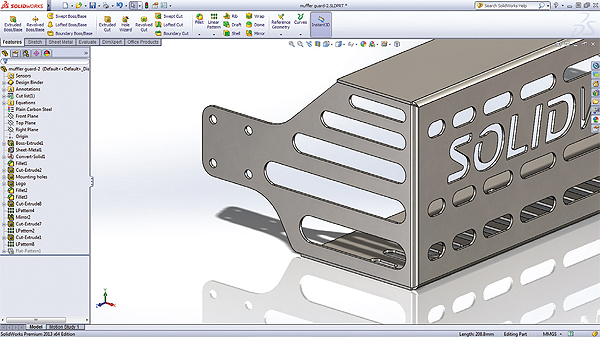
SolidWorks 2013 includes a Varying Dimension Pattern tool, for creating patterns with varying spacing and feature size.
What the future may bring
While DS SolidWorks has not talked recently about its next generation V6 product line, it’s still very clear that the company is heavily focused on it. Eventually, DS SolidWorks would like to migrate users away from the V1 generation product, which is based not only on a nearly 20 year-old architecture, but which uses Parasolid and DCM—technologies licensed from its competitor, Siemens PLM Software.
Even if DS SolidWorks has been working on their next generation V6 product for several years already, it will still take several years after its first public release for it to gain the functionality necessary for it to be a viable alternative to the V1 generation product. (And no V6 product will be a viable alternative unless it completely supports all the legacy data created by the V1 generation product.)
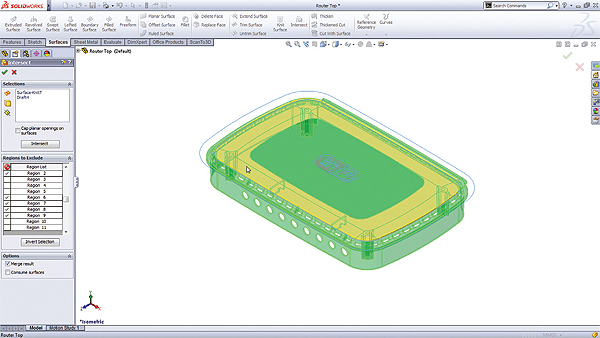
The surface/solid intersect feature supports selection of common regions created by multiple solid and surface bodies.
CAD industry analysts with whom I’ve spoken estimate that it might reasonably take 10 years to transition SolidWorks V1 users to the SolidWorks V6 platform. Even then, there will likely be some laggards who will never change. (CATIA V5 has been out 15 years, and some aerospace companies are still using V4.)
Looking carefully at SolidWorks 2013, it appears that most of the improvements are around the edges—things that don’t require deep surgery into the core of the SolidWorks code. Consider the addition of conic curves, solid/surface intersections, and parallel updates to drawing views: These appear to be capabilities enabled (mostly) by new versions of Parasolid and DCM.
Given that DS SolidWorks is working on the next generation SolidWorks V6 platform, it makes perfect sense that it would focus its SolidWorks V1 work not on core innovation, but rather on rock solid stability.
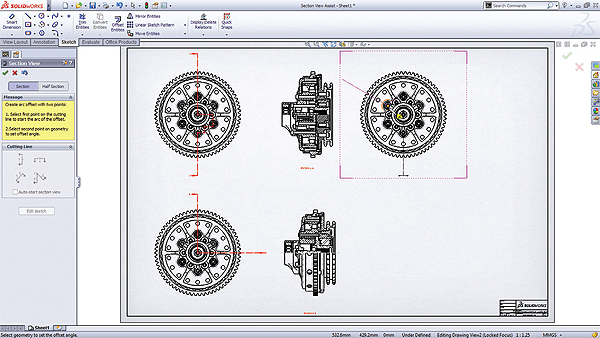
Creating complex section views used to be a tedious process. It’s now easy and interactive, with pop-up choices for creating quick jogs.
Focusing on stability doesn’t preclude adding significant value. SolidWorks Plastics, and SolidWorks Electrical are major add-ons for SolidWorks, which demonstrate this. These programs were not developed by DS SolidWorks, but were licensed from third party developers (Simpoe and Trace Software, respectively.) They’re both high quality tools that add greatly to SolidWorks’ value and utility, and do so without adding significant bugs or stability issues.
Even though it’s dangerous to make predictions about software that’s not yet out, SolidWorks 2013 provides a hint of what’s likely to be in the future for SolidWorks V1 generation products: a focus on quality, productivity, and performance; Most likely in that order.
Dassault Systèmes SolidWorks Corp.
www.solidworks.com
Filed Under: Software • 3D CAD, ENGINEERING SOFTWARE

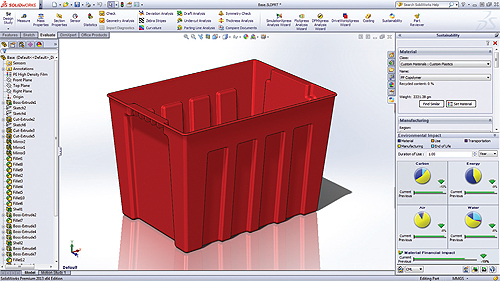
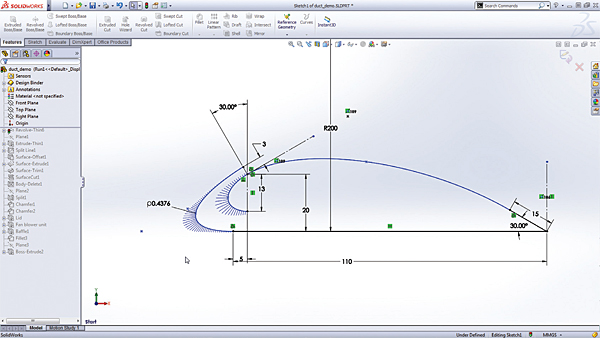
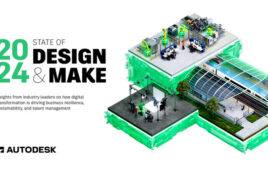



To your comment “SolidWorks 2013 includes more than 200 customer-driven improvements. While they don’t provide an exhaustive list of these improvements”, No so fast, these “200” are mentioned quite openly in the What’s New document. Count the individual articles in the document (minus the How-To’s). 🙂